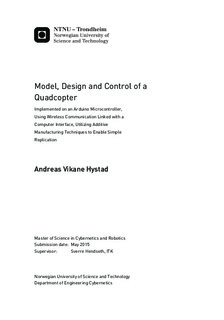Model, Design and Control of a Quadcopter - Implemented on an Arduino Microcontroller, Using Wireless Communication Linked with a Computer Interface, Utilizing Additive Manufacturing Techniques to Enable Simple Replication
Master thesis
Permanent lenke
http://hdl.handle.net/11250/2352467Utgivelsesdato
2015Metadata
Vis full innførselSamlinger
Sammendrag
The popularity of the quadcopters is increasing as the sensors and control systems are becoming more advanced and less expensive. There are many commercial quadcopters available on the market today, but they are often hard to configure and comprehend. The time required to grasp the existing systems, could be spent designing better solutions. This project aims to use understandable system descriptions and sensor models as a basis to design configurable estimators and controllers, and to build a quadcopter well suited for educational purposes; as well as aiding to more advanced control in the future.
The system consists of several components for necessary sensor input, a radio transmitter, Windows user interface and an Arduino microcontroller. All filtering of signals, estimation of system states, calculation of control inputs and communication handling is done on the microcontroller, while the Windows application allows the user to command various actions. To achieve simple replicability, a 3D model of the frame was developed by an "Experts in Team" group. This provided us with useful experience in project management.
Satisfactory attitude estimates were obtained, a stable attitude controller was deduced and implemented, a user controlled Windows application was successfully developed and a quadcopter frame was created through additive manufacturing.
